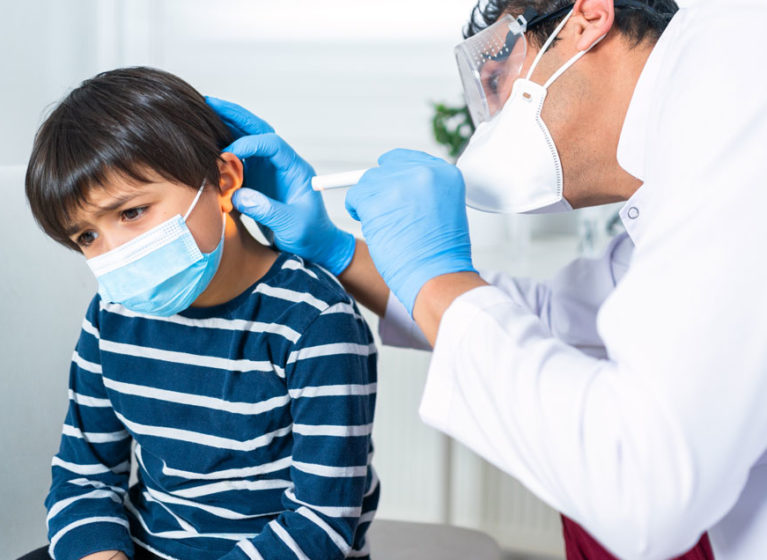
From birth, the ability to hear is essential for language and speech development. For children born with aural atresia — the lack of a fully developed ear canal and middle ear in one or both ears — UVA Health’s aural atresia repair program offers hope for a normal life.
“These children are born with a moderate to severe hearing loss, and after surgery, many times I can bring their hearing into the normal range,” says neurotologist Bradley Kesser, MD, a professor in UVA Health’s Department of Otolaryngology - Head and Neck Surgery. “Intervention may help a child meet his or her full potential.”
UVA Health is internationally recognized for expertise in congenital aural atresia repair, also known as canalplasty. Parents from all over the world bring their children to UVA Health for the surgery, which opens the ear canal and restores the ear’s natural sound-conducting mechanisms. It’s one of the few medical centers in the United States with a comprehensive program offering hearing evaluation, analysis of middle ear anatomy, outer ear reconstruction, a comprehensive discussion of hearing habilitation options for these children and their families, and revision procedures as needed.
Restoring Hearing
Aural atresia affects about one in 10,000 to 20,000 children (primarily male), with about 70% of these cases involving only one ear – most commonly the right ear. In most patients, the condition is seen in combination with microtia, a deformity resulting in a small, undeveloped outer ear. UVA Health also offers cosmetic reconstruction of microtia, often coordinating the procedure with aural atresia repair.
Aural atresia repair starts with creating an ear canal by drilling a channel into the skull to the middle ear, where the small ear bones (ossicles) are located. Facial nerve monitoring is critical throughout this process to prevent facial paralysis. Next, the surgeon constructs an eardrum, or tympanic membrane, and lines the new bony ear canal with a thin skin graft, usually harvested from the patient’s upper arm or thigh. Finally, an opening, or meatus, aligned with the new canal, is created in the reconstructed auricle.
“The finished result is a healthy, skin-lined ear canal with a tympanic membrane and ossicles that vibrate freely to allow the efficient conduction of sound energy to the inner ear,” Kesser says. “In carefully selected patients, the chances of achieving normal or near-normal hearing with surgery approach 90%.”
Success Depends on Right Candidate & Timing
Kesser’s mentor, Robert Jahrsdoerfer, MD, pioneered this groundbreaking procedure in the late 1970s. But not all children with aural atresia are candidates for the procedure. Jahrsdoerfer developed a 10-point grading scale for evaluating a child’s ear anatomy and determining their candidacy for aural atresia repair surgery. Kesser and colleagues have conducted research showing that children scoring seven or higher on the scale have an 80 to 90% chance of achieving normal or near-normal hearing after the procedure.
The timing of atresia repair depends on many factors, including a patient’s age and maturity, and the type of outer ear reconstruction they will undergo.
“I generally do not recommend atresia repair, either in children with unilateral or bilateral atresia, until they are old enough to cooperate with the hearing testing and postoperative care that is absolutely necessary to ensure an excellent result,” Kesser says.
Non-Surgical Options Available
For children who are not candidates for the surgery, UVA Health offers other options, including bone-conducting hearing devices. Children under 5 years old would wear a device attached to a strap or headband, with the oscillator on the outside of the body. The device also can be surgically implanted on the skull and attached by a post or magnet to a sound processor outside of the head. The FDA has not approved this surgical procedure for children under 5 years old.
Global Referral Center
UVA Health is a global referral center for surgical repair of the ear canal. Families from around the world send Kesser their child's imaging results and hearing tests to find out whether their child qualifies for the procedure.
Kesser is engaged in research to better understand hearing mechanisms in children with aural atresia. One of his latest studies involves examining whether children can locate sound in space and better hear in background noise after surgery.
“For children who have aural atresia in both ears, when you open the ear and allow them to hear, it really is life-changing,” Kesser says. “It's quite powerful; it's a very gratifying practice.”